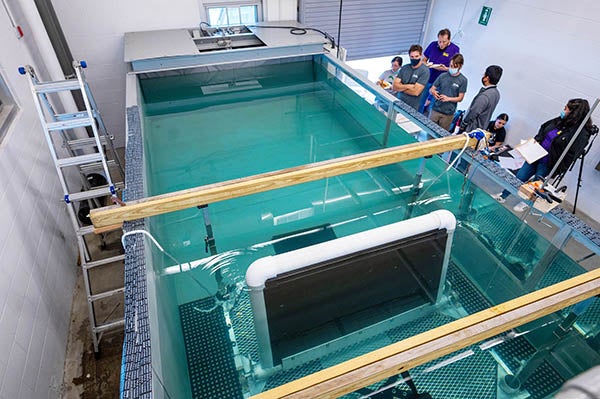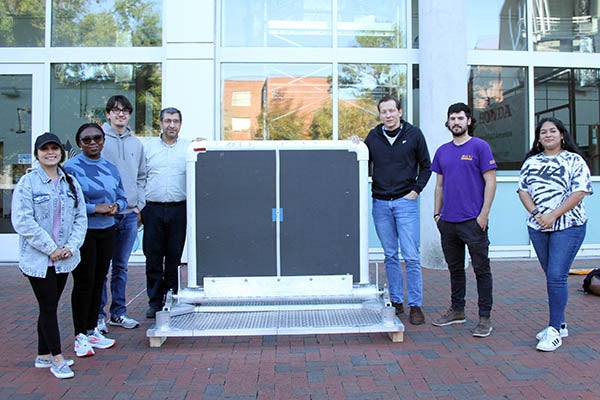WAVE TO WATER
ECU students complete initial tests for desalinization unit
It’s called wave to water, the goal of which is to make freshwater out of saltwater using energy created by the waves.
A team at East Carolina University is working on the effort, and five engineering students just completed one of the first steps toward making the wave energy desalinization unit a reality as part of their senior capstone project.
Olusola Bolarinwa, Denia Cruz, Jason McCarthy, Emely Morales and Matthew White had the chance to travel to the Coastal Studies Institute in Wanchese to test one part of the system, a flap that will move as waves strike it. Fellow students Erica Walker, Cora McQuaid and Hunter Pigg also joined in the effort.

The flap section of a wave energy desalinization unit is prepared for testing in a wave tank at the Coastal Studies Institute. (Photo by John McCord)
“This is just the start of it,” Morales said. “We’re like the first ones to do this. I think it’s pretty cool.”
As the flap moves, it creates the energy that will be used to desalinate saltwater. That can be crucial during a disaster when freshwater may not be available and the power is out.
“The idea is to have something mobile that can be functional near shore,” said Dr. Tarek Abdel-Salam, director of ECU’s Center for Sustainable Energy and Environmental Engineering and one of those involved in the project. “This is what this device is. It’s not going to be in the middle of the ocean. It’s going to be near the shore. This device is supposed to deploy quickly and provide either fresh water or electricity if we need it to people in areas of disaster such as in a hurricane.”
The students started the project in January.
“Probably the hardest part was getting started,” White said. “We had to learn what we didn’t know.”
The students — led by Dr. Faete “JT” Filho, assistant professor in the Department of Engineering — floated a number of ideas before creating the roughly 230-pound flap as well as a base on which to mount it.
“It’s a really big project for the amount of time we had, especially for a capstone project,” McCarthy said. “We actually worked on it over the summer to do most of the building, creating it, welding it all together and assembling it.”
Once it was completed, the team moved to the testing phase, which included a trip to Wanchese and CSI’s wave tank.
“Testing day was really, really fun, working with the CSI people and their team,” Morales said.
Two people had to get into the tank to guide the device into place.
“We got it in the tank and didn’t break anything. It stayed together,” McCarthy said. “We got usable data out of it, and another group is going to use that data to validate the simulation models that they’ve created, so I would say it was a success. There was one test where the water actually went over the side of the tank, and that was really exciting.”
The data created during the test is being analyzed by team members Gabriel Glosson, Jason McMorris and Morgan Blanchard and will provide information for the next-generation device to be built.
Seeing what they created work was sweet validation for the team.
“Just seeing our project come together was fun,” Cruz said.

From left, Denia Cruz, Olusola Bolarinwa, Matthew White, Dr. Tarek Abdel-Salam, Dr. Faete “JT” Filho, Jason McCarthy and Emely Morales stand with the flap that is part of a wave energy desalinization unit that ECU is creating. (Photo by Ken Buday)
And the team learned some lessons along the way.
“I think the most optimal way to go about doing it would have been to do simulations and then build it,” McCarthy said. “But because we had such a limited time period, we wanted just to get something built and in the water, get some data and go from there.”
Capstone projects are designed to give students a taste of what their careers will be like.
“It definitely gives you that connection between school and the real-world experience,” Cruz said.
“Compared to all my other classes, this was really the only hands-on experience I had,” McCarthy said. “We got to communicate with outside vendors, go back and forth with them, and then actually put stuff together. It’s something I enjoyed being a part of for sure. It’s cool to say I had the opportunity to be a part of it.”
Of course, the flapper design is just the first step in the overall project that received funding as part of a University of North Carolina System Research Opportunities Initiative grant. The project is also getting support from the U.S. Testing Expertise and Access to Marine Energy Research program that allows ECU to work with top researchers in the Department of Energy’s National Renewable Energy Laboratory, in Golden, Colorado.
“We’re about halfway through the project,” Filho said. “The first half is design and analysis. The second part is to make the product itself, and that’s what we’re doing right now. The third phase is to start the testing.”
Other senior capstone teams are working on other aspects of the project.
“The students are doing an outstanding job,” Filho said. “It’s really rewarding to see them engaged in this project and helping us advance renewable energy technologies.”
Along with Filho and Abdel-Salam, the team includes Drs. Kurabachew Duba and Zhen Zhu from the Department of Engineering, Dr. Mike Muglia from the Coastal Studies Institute, and Dr. Mehran Elahi of Elizabeth City State University.
Abdel-Salam pointed out that similar devices store the renewable energy from the sun or ocean waves in batteries. What makes ECU’s device unique is that batteries won’t be used.
“Instead of storing it and needing batteries, we just take it right away and convert this ocean energy to mechanical energy, without needing batteries or electrical pumps to pressurize the water for desalinization,” Abdel-Salam said.
Abdel-Salam gave credit to Filho for overseeing the students on this phase of the project, which he said has broad implications for students and for ECU.
“It’s not only helping our students and our faculty, but it’s very good for ECU,” he said. “ECU is known now for growing research in water desalination and ocean energy.”

The team after testing at the Coastal Studies Institute in Wanchese. (Photo by John McCord)
